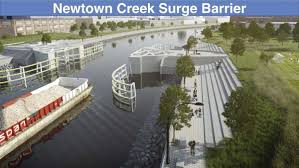Adapting to a changing climate and mitigating the risks is already big business and it will only get bigger.
Just through 2020, the annual market for "climate adaptation services" is estimated to grow 12-20% a year – a
$700-million market in the US and $2 billion globally, concludes a study by Environmental Business International.
Today’s market is led by consulting & engineering and specialty firms working primarily for government agencies in analysis, risk management and planning, but increasingly it will tilt to project implementation and construction.
Few assets in the world will escape the effects of climate change. Governments at the local, state, regional and national levels are in the midst of seriously considering its threat to public health and epidemiology, agriculture, power production, transportation, town planning, coastal protection, and water resources.
Some, like New York City, have moved beyond serious consideration to detailed scenario analysis, planning, even initial design and construction of preventative measures. It’s even opening a cleantech incubator that supports startups in this area.
Surge barrier planned for NYC:

Currently, cities are on the front lines of severe weather events and are more proactive than federal governments – two-thirds of cities around the world are actively planning for the impacts of global warming.
Hundreds of funded projects are already being steered to planning and project management firms with climate adaptation experience, if not a dedicated practice area, the study finds.
"Companies with expertise in water security are on the front lines of addressing changing climate adaptation," says Grant Ferrier, President of Environmental Business International.
"Several leading consultancies have cut their teeth in Australia and other countries where governments have been forced to come to terms with chronic water scarcity. And now they’re bringing that expertise to Texas and parts of the US hit hard by drought and extreme heat."
While academics, think tanks and government research entities have done the bulk of published material to date, consulting & engineering firms are driving the conversation about climate change adaptation, often in the context of risk management when talking to clients in water and wastewater utilities, energy, land management and various levels of federal, state and local government.
Industries first to be affected, like power, water and agriculture are producing early adopters investing time, resources and project dollars to assess their risks, and in some cases prepare for numerous and still largely unpredictable, though many would say inevitable, outcomes.
Environmental consulting & engineering firms, specialty boutique firms and some architecture & engineering (A&E) firms and engineering, procurement and construction (EPC) contractors will be on the front lines of mitigating and preparing to cope with the impacts of climate change.
However, once capital planning for adaptation turns into capital spending, the design and construction of adaptation measures will begin in earnest. There will be sustained and even higher growth rates driven by major construction projects such as desalination plants, levees, sea walls, port reinforcements, relocations, diversions, and others.
"While there is a certain inevitability about climate change. No measure of planning done to date can completely prepare us for the circumstances we will face in the future. But as an old saying goes: ‘Fortune favors the well prepared’ and the fortunes of many will be lost or saved by effective adaptation planning," Ferrier says.
Here’s the report, "Climate Change Adaptation":
